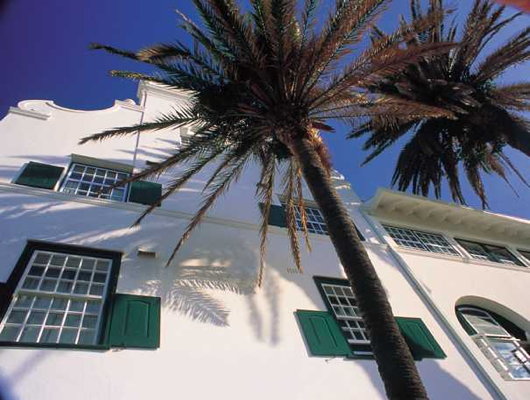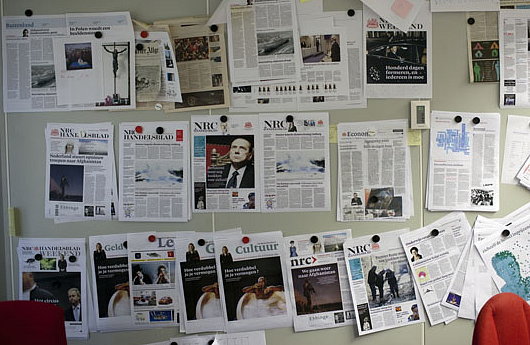World
About Andrew Cusack
 Writer, web designer, etc.; born in New York; educated in Argentina, Scotland, and South Africa; now based in London.
Writer, web designer, etc.; born in New York; educated in Argentina, Scotland, and South Africa; now based in London. read more
News
Blogs
Reviews & Periodicals
Arts & Design
World
France
Mitteleuropa
Knickerbockers
Argentina
The Levant
Africa
Cape of Good Hope
Netherlands
Scandinavia
Québec
India
Muscovy
Germany
Academica
Winchester Mansions
STARING ACROSS Sea Point Promenade towards the waters of the Atlantic in Cape Town, there sits Winchester Mansions. The hotel was built in 1922 in a style emblematic of the period’s revival of interest in the Dutch colonial age at the Cape. People often associate the 1920s with Art Deco, but the style was only just emerging in Paris at the time, and wasn’t even called ‘Art Deco’ until the 1960s. The ‘mother city’ has its fair share of Art-Deco and Moderne buildings, but architectural trends took a while to arrive in South Africa — though they tended to last longer then elsewhere. The Cape Dutch Revival emerged in the 1890s and perhaps reached its high-water mark in the 1900s and 1910s. Curiously, it is not associated with the simultaneous emergence of Afrikaans as a language and the rising consciousness of Afrikaner identity, but rather with a very Anglo and colonialist mindset. It was Dorothea Fairbridge and Milner’s ‘Kindergarten’ — respectively the social and political forces seeking to unite all of South Africa under the British crown — that promoted the adoption of the Cape Dutch as a national style. Thus the years leading up to Union in 1910 and its initial decade or two were the heyday of the Cape Dutch Revival as it was the favoured boustyl for the respectable Cape- and Rand-based imperialists.
Towards a Confucian Modernity
MY RESPONSE TO Samuel Huntington’s coming clash of civilizations concerns the desirability and necessity of a dialogue of civilizations. Hegel, Marx, and Max Weber shared an ethos that, despite all its shortcomings, the modern West informed by the Enlightenment mentality was the only arena where the true difference for the rest of the world would be made. Confucian East Asia, Islamic Middle East, Hindu India, or Buddhist Southeast Asia were on the receiving end of this process. Eventually, modernization with homogenization or convergence will make cultural diversity inoperative if not totally meaningless. It was inconceivable that Confucianism, or, for that matter, any other non-Western spiritual tradition, could exert a shaping influence on the modernizing process. The development from tradition to modernity was irreversible and inevitable. In the global context, some of the most brilliant minds in the modern West assumed this to be self evidently true, but nowadays it has turned out to be only part of the big picture. In the rest of the world, and arguably in Western Europe and North America, the anticipated clear transition from tradition to modernity never occurred. As a norm, traditions continue to make their presence in modernity, and indeed the modernizing process itself is constantly shaped by a variety of cultural forms rooted in distinct traditions. The eighteenth century recognition of the relevance of radical otherness to one’s own self-understanding seems more applicable to the current situation in the global community than the attention to any challenges to the modern Western mindset of the nineteenth century and the first half of the twentieth century. (more…)
The Architecture of Immaturity

Have you ever come across the French Ministry of Culture on the Rue Saint-Honoré? It’s a perfect example of the architecture of immaturity. The government ministry was formerly strewn across nineteen different sites throughout Paris. The decision was made to consolidate their offices in one place, and the suitably central location near the Palais Royal was chosen.
The main building on the site is a handsome building from the late nineteenth-century or at the latest 1900s, with a modern 1960s office building stuck behind it. The Ministère chose architect Francis Soler to “unify” the buildings into one. At first, this was meant to be done solely through an interior reorganisation, but Soler decided to add a strange grille to the façade. (more…)
Fra Freddy, Rest In Peace
Yesterday, I was very saddened to hear of Fra Freddy’s death. Fra Freddy was a legendary character whom I was introduced to in my first year at St Andrews. He was invited to speak to the Catholic students most years on some subject or another — an introduction to prayer or a lenten meditation. I was quite pleased when he was so taken with a poster I designed to advertise one of his talks that on his way back to Edinburgh he nipped out of the car at the last minute and grabbed a large copy. Fra Freddy was an old-fashioned stick-in-the-mud with a good sense of humour, but he also had the capability to surprise with a kind word when you least expected it.
Fra Fredrik John Patrick Crichton-Stuart was born September 6, 1940 to Lord Rhidian Crichton-Stuart (son of the 4th Marquess of Bute) and his wife Selina van Wijk (daughter of the Ambassador of the Queen of the Netherlands to the French Republic). He was raised in Scotland and North Africa (where his father was British Delegate to the International Legislative Assembly of Tangier) and was educated first at Carlekemp in North Berwick and then at Ampleforth. He joined the Order of Malta in 1962, later being named the Delegate for Scotland & the Northern Marches. In 1993 he was appointed Chancellor of the resurrected Grand Priory of England. Fra Freddy became Grand Prior himself when his cousin, Fra Andrew Bertie, died in 2008 and was succeeded by the then-Grand Prior of England, Fra Matthew Festing.
Fra Freddy was a devoted follower and promoter of the traditional form of the Roman rite. He joined Una Voce Scotland in 1996 and became secretary in 2000. Two years later he was named councillor and senior vice-president of FIUV, the International Federation ‘Una Voce’, and briefly served as its president in 2005.
Over the past year or so Fra Freddy had been varying ill but seemed to recover. I am told he was found dead yesterday morning, still clasping his breviary. He was well-known in Edinburgh and beyond, and he will be missed by his many friends as well as those who worked and volunteered with him or interacted with him in his charitable activities.
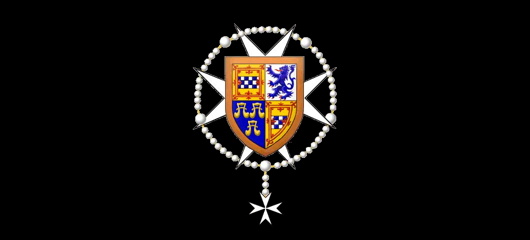
FREDERICK JOHN PATRICK CRICHTON-STUART
Grand Prior of England
of the
Sovereign Military & Hospitaller Order of St John
of Jerusalem of Rhodes and of Malta
6 September 1940 – 14 June 2011
Eternal rest grant unto him, O Lord,
and let perpetual light shine upon him.
May he rest in peace.
Amen.
Cooking with Sir Laurens van der Post
East and West Meet at the Cape
The Cape Malays came up with dishes that are all so a part of the South African way of life that they have become almost sacramental substances. Among them are bobotie, sosaties, and bredie. Bobotie, a kind of minced pie, is to South African what moussaka is to the Greeks. Sosaties, or skewered and grilled meats are what shashlyk are to the people of the Caucasus and shish kabob to the Turks. The stew called bredie is what goulash is to Hungarians.
A basic bobotie begins with minced lamb or beef, a little soaked bread, eggs, butter, finely chopped onion, garlic, curry powder and turmeric. All are mixed together, put in a pie dish with meat drippings, and baked in a low oven for a time. The moment the mixture begins to brown, the dish is taken from the oven and some eggs beaten up with milk are poured over the top; then the dish is put back into the oven and baked very slowly to a deep brown. The pace of the cooking is important: if the oven is too hot the bobotie will be dry, and that should never happen, for an ideal bobotie is eaten moist, over rice. (more…)
The Advent of Virgin Australia

Virgin Atlantic Airways has always inexplicably attempted a fine balance between the crisply modern and the vaguely old-school. It is also unashamedly British. When the lumbering giants at British Airways were busy banishing the Union Jack from their aircraft livery — prompting Baroness Thatcher to cover the model of a BA 747 with a handkerchief — Sir Richard Branson said “We’re British: why don’t we fly the flag?” The Union Jack was added to every Virgin Atlantic plane and a flag design was later added to the wingtips. Virgin Atlantic now has a patriotic red-head (above) bedecked in the Union flag on the nose of each of its aircraft glamourously advertising their national origins in this hyperglobalist age.
Virgin Group has not restrained itself from expanding beyond the trans-Atlantic flightpath. In 2000, they established Virgin Blue in Australia, originally flying only between Brisbane and Sydney, but gradually expanding within the country, especially after the 2001 collapse of the major domestic carrier Ansett Australia. In 2003, Virgin started Pacific Blue Airways out of New Zealand, operating trans-Tasman routes, followed by the founding of Polynesian Blue in 2005 running flights between New Zealand, Australia, and Samoa. Finally, V Australia was started operations in 2009 running long-haul flights out of Australia. (more…)
Les fondements de notre civilisation occidentale
« Les fondements de notre civilisation occidentale sont chrétiens ; le respect du christianisme est une condition sine qua non d’une droite qui veut conserver non seulement la prospérité économique, mais ce qui est au fondement de toute prospérité durable : le souci du bien commun, le respect de la loi naturelle, le sens de la justice. »
The latest issue of Égards, the premier journal of traditional conservatism in Quebec, contains an interesting analysis of the current situation faced by the various streams of the centre-droit spectrum in the province. I am, however, very much against the perpetual organisation-founding that goes on in political circles. There seems to be a belief that, when in doubt, start a new organisation, but this is precisely what the author, M. Décarie, proposes.
Dublin Diary
WE START OUT at the usual Italian place, PH’s stammtisch despite his complaints that they’re stingy and never bring you a limoncello at the end of a meal, as is custom elsewhere. The usual verbal briefings are exchanged, updating each other on the scheme of things and the general banter. It’s warm enough to sit outside, which allows us the luxury of a cigarette with our coffee as we cast aspersions on passing strangers. This quickly moves on to casting aspersions on mutual acquaintances (we will not call them friends!) and extrapolating therefrom more general condemnations of the heresiarchs and heretics of our day (chiefly: liberals, Modernist clergy, fops, les Brideshead affectés, users of inappropriate typefaces, and all people who take life too seriously).
After the postprandial coffee, we head on to Doyle’s but, just as we arrive, Brian gets in touch directing us elsewhere. We meet up with him and his three friends on the street but PH and I do not take a shine to Brian’s temporary entourage and secede from the party. Where to? Lincoln’s Inn, end of Nassau Street. (more…)
Nobility and Dignity at the Café Valois
Farewell, O good old days! Farewell, O affable visage of the proprietor and smiling and respectful reception of the waiters! Farewell, O solemn entries of the Café Valois’ dignified customs, which people were curious to see. Such was the case with the Knight Commander Odoard de La Fere’s arrival.
At exactly noon, the canon of the Palais-Royal heralded his arrival. He would appear on the threshold and pause for a moment to sweep the salon with an affable and self-assured gaze as someone eager to practice a longtime custom. His right hand pressing firmly on the white and blue porcelain handle of his cane, he threw his old faded brown cape over his shoulder with a swing of his left hand. No one ever snickered at this, since not even the most elegant mantle with golden fleur-de-lys embroidery was ever thrown back with a more distinguished movement.
In 1789 the former steward of the Prince of Conti ran the Café Valois; it was rather devoid of political colour and local flavor at that time.
Among the frequenters of the place, standing out by his noble manners, stately demeanor and wooden leg, was the Chevalier de Lautrec. He was from the second line of that family, an old brigadier of the king’s army, a Knight of Malta, of Saint Louis, of Saint Maurice and of Saint Lazare.
The Chevalier de Lautrec was a middle-aged man who lived a modest, though very dignified life on his small pension. Though he rarely appeared in society, he could be seen most often at the Palais Royal and the Café Valois. He was a very cultured mind and an assiduous reader of all the newspapers.
Deprived of his pension overnight, it was never known what the Chevalier de Lautrec lived on at a time when it was so difficult to live, and so easy to die. But here we have something that sheds at least a dim light on this mystery.
One morning after finishing a very modest breakfast in the Café Valois, as was his custom, the Chevalier de Lautrec rose from his table, chatted with all naturalness with the proprietress, who stood behind a counter, bid good-day to the master of the café with a slight gesture of the eyes, and walked out majestically saying nothing about the bill. (more…)
Licorne Perdue

“Vu hier soir à Odéon” writes Nicholas S-M, posting this photo on Facebook.
Of course, my mind immediately wanders to Le Secret de La Licorne, the 3D film version of which (directed by Mr. Spielberg) will be released before the end of the year. I am sure I will hate it, but in that way you can hate things while still liking them.
Civilised Barbarism, Barbaric Civilisation
“Despite my inclinations to the contrary, I have racial sensitivities. I am Latin. I regard the civilised barbarian in the North with an inherited sense of mistrust. Today [the United States] has become a colossal society, and has adopted the goal of imposing its industry, its commerce, and its imperialism. Each citizen of the Union is a kind of stockholder… [upholding] an ideal of material perfection above moral perfection, and equating civilisation with the triumph of industry and commerce. We, by contrast, descendants of the Latins and educated by the Greeks, regard that person as most civilised who is most morally perfect. … I am proud to say I am bored with railroads and factory chimneys.” – Belisario Montero
ONE OF THE best aspects of Catholicism is the affirmation (for lack of a better word) of absolutely everything that is good throughout the world. All the peoples of the earth, each with their particular genius, eventually descend from the same parents. This gives one, I hope, a certain sympathy towards every nation and every people, and an anticipation that each one will eventually grow into the full flower of a Christian order appropriate to their particular characteristics and personality. Christianity is not oppressive and conformist in its universalism but instead all-embracing.
There is much to be admired in the sentiments expressed by Belisario Montero, an Argentine diplomat, in the comments cited above. To put them in context, they were made after the final collapse of the Spanish Empire following the Spanish-American War of 1898. Argentina, as you already know, is a place that excites me. In her is found so much of the idea of Europe, varyingly perfected and perverted, accidentally demolished in an attempt to save it and then put back together again not precisely as it was before. Marx “travelled” to Buenos Aires, but so did Maurras (and perhaps the Frenchman was more influential). For a time, photographs of Mussolini cut from the illustrated magazines were plastered onto the walls of aspirational working-class porteños trying to keep up with the latest European fad, and the military elite and social aristocracy combined to oppose the vulgar and destructive forces of liberal democracy and unbridled capitalism. Almost every coup in the nation’s history was received with a sigh of relief, especially (and ironically) the coups getting rid of whomever the previous welcome coup put in charge. Argentina has a long history of terrible success and beautiful failure. Perón himself is the very embodiment of this.
Of course, unlike Don Belisario, I am not a Latin. (more…)
Arms of the Irish Universities
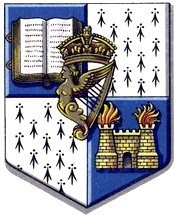 University of Dublin
University of DublinUniversitas Dublinensis; Ollscoil Átha Cliath
Dublin University was founded with the idea of creating a collegiate university along the Oxford and Cambridge model. The University of Dublin, however, failed to develop along those lines, and so its sole foundation was the College of the Holy and Undivided Trinity of Queen Elizabeth near Dublin, more commonly known as Trinity College. Strictly speaking, TCD and the university are distinct entities in law, Trinity being the only college of the university.
The university’s arms, granted in the nineteenth century, are blazoned Quarterly azure and ermine. First quarter a book open proper, bound gules, clasped or, and in fourth quarter a castle of two towers argent, flamant proper. Overall in the centre point the harp of Ireland ensigned with the royal crown. The castle with fired towers is a reference to the arms of the city of Dublin. While it is the university, not Trinity College, that awards degrees, the university arms were not used on degree certificates until 1963, when President John F. Kennedy was granted an honorary doctorate of law in St. Patrick’s Hall at Dublin Castle. (more…)
A Little More Graaff-Reinet
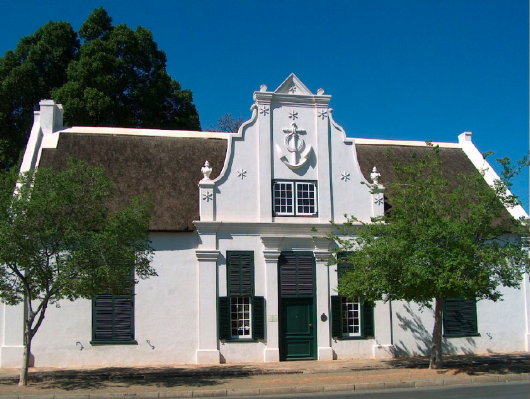
Here’s just a handful more photos of Graaff-Reinet from the blog of Angelika Wohlrab, a South African tour guide, author, and photographer. Above is another Cape Dutch gem, the Urquhart House with its splendid plasterwork design in the gable. (more…)
Graaff-Reinet
The Gem of the Karoo
IF YOU HEAD OUT from Cape Town making for the Valley of Desolation, you take the main road to Johannesburg, breaking ranks at the town of Beaufort-West in the Great Karoo, where you head eastwards on the R61. That road eventually joins up with the N9 (famous for its “Uniondale Ghost”) and, before you reach the Valley, takes you to the pleasant little town of Graaff-Reinet. The town was founded in 1786, making it the fourth-oldest in South Africa, after Cape Town — the “mother city” — Stellenbosch, and Swellendam. Graaff-Reinet was named in deference to the Dutch governor of the day, Cornelis Jacob van de Graeff, and his wife whose maiden name was Reynet, but the burghers earned an early reputation for rebelliousness, proclaiming their own independent republic in 1795, with further uprisings in 1799 and 1801. While now situated in the Xhosa-dominated Eastern Cape, Graaff-Reinet is predominantly Afrikaans.
The town, which rests on a bend in the Sunday’s River, has a host of architectural delights, of which my favourite is the Reinet House (below). It was built in 1812 as a parsonage for the Dutch Reformed minister, and was later part of the teacher training college until it fell vacant and was restored as a museum after the Second World War, being opened in 1956 by the Rt. Hon. E.G. Jansen, the Governor-General of the day.
The Namibian Way of Reconciliation
Accepting differences, not erasing them, is the path to civic harmony
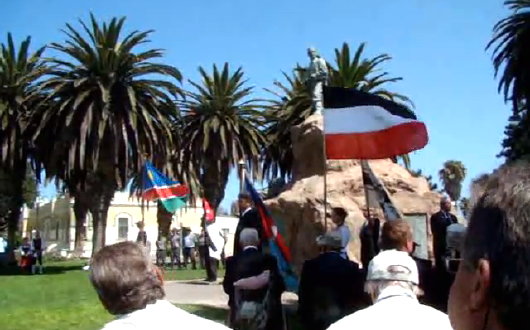
DISCORDIA GERANT ALII, tu felix Namibia reconciliant! Peace and reconciliation are amongst the noblest of earthly aims, but the deluded establishment that rules most of what used to be called the Western world often seem convinced that peace among peoples can only be achieved by erasing the differences between them. Yet it is precisely those differences — the unique characteristics of tribe, clan, and platoon that separate us from some and unite us with others — that make us who we are: human beings, created by God in time and place and circumstance. Without them, we are rootless citizens of nowhere, easily abused and manipulated by the powerful. (How flimsy is even the thickest oak when its roots have been severed). It is the acknowledgement of differences, rather than the erasing of them, that leads to true respect and understanding between and among peoples. While the racial grievance industry thrives in America and Europe, an entirely different attitude exists in happy Namibia. (more…)
Moedertaalsprekers in Suid-Afrika
Vanuit die blog van die “vryskut visuelejoernalis” Charles Apple, ons kry hierdie grafiek van sprekers van die twaalf offisiele tale van Suid-Afrika. Dit is die werk van die grafiese kunstenaar Rudi Louw van Naspers. Dié grafiek het in Die Burger verskyn. (O, Die Burger! Ek mis jou!). Afrikaans is nie eerste in nommers nie — Zoeloe is bo-op, Xhosa is volgende — maar die taal is eerste in ons harte. (Awww…) (more…)
NRC Handelsblad Goes ‘Compact’
Another broadsheet bites the dust
ONE OF THE most prominent newspapers in the Netherlands, NRC Handelsblad, switched from broadsheet to tabloid size this week. The newspaper claims it is returning to the ancestral format of its predeccesors, the Algemeen Handelsblad, the Amsterdam newspaper founded in 1828, as well as the Rotterdam Courant, founded in 1844. Those two papers merged in 1970 to form NRC Handelsblad, which is the seventh in circulation among the national newspapers of the Netherlands.
The evening newspaper has gained experience in tabloid-size printing since 2006 when it launched its morning compact edition, nrc.next, aimed at young, highly educated readers. Nrc.next has a Monday-Friday circulation of over 300,000, while NRC hovers around 240,000 on weekdays and 270,000 on Saturdays.
Interview with the Last July 20 Plotter
Der Speigel speaks with 88-year-old Ewald von Kleist
Ewald von Kleist is the last surviving member of the circle of Wehrmacht officers who participated in the July 20, 1944 plot to kill Hitler and overthrow the Nazi state. Der Spiegel has translated its interview with him into English, and all four pages feature interesting insights from this brave old man.
And if you read German (I don’t), you might be interested in this article on China & Carl Schmitt.
Canada’s Temporary Commons
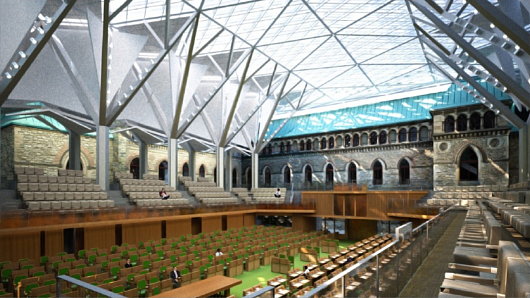
Canada boasts one of the most imposing parliamentary complexes in the world, presiding from a lordly bluff in the federal capital of Ottawa. While I think the city could do with an overall Hausmannisation, the government of the Confederation is undertaking significant efforts to renovate the buildings on Parliament Hill.
While the House of Commons chamber is renovated, the dominion’s lower house will meet in a new temporary chamber (above) constructed in the inner court of the West Block, one of a pair of high Victorian Gothic structures that flank the main parliament building. The restoration will take five to seven years, after which the temporary chamber will be converted into parliamentary committee rooms.
The Commons in the Lords
IT WAS THE NIGHT of 10 May 1941. For nine solid months the Luftwaffe had thrown everything it had at the people of London, as Hitler hoped to bomb the English into despair and surrender. By early May, the Nazis realised the campaign had failed, and resources had to be directed elsewhere. The Blitz had to end, but on its final night, it hit one of its most precious targets. Twelve German bombs hit the Palace of Westminster that night, with an incendiary striking a direct hit at the House of Commons. The locus of Britain’s parliamentary democracy was consumed by flame and completely destroyed. (more…)
Search
Instagram: @andcusack
Click here for my Instagram photos.Most Recent Posts
- Sag Harbor Cinema March 26, 2025
- Teutonic Takeover March 10, 2025
- Katalin Bánffy-Jelen, R.I.P. March 3, 2025
- Substack Cusackiensis March 3, 2025
- In the Courts of the Lord February 13, 2025
Most Recent Comments
Book Wishlist
Monthly Archives
Categories

